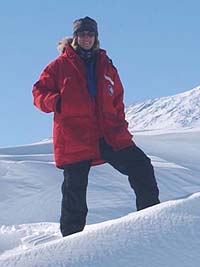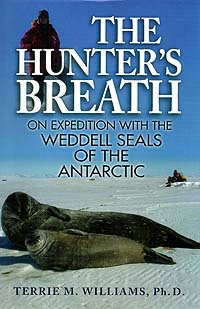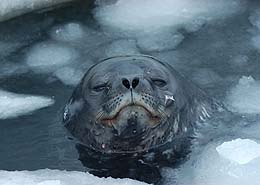|
April 26, 2004
Biologist Terrie Williams tells a story of adventure
and discovery in Antarctica in her new book, The Hunter's Breath
By Tim Stephens
In six trips to Antarctica, biologist Terrie Williams endured brutal
conditions on the coldest, driest, windiest continent on Earth in order
to learn the secrets of the mysterious Weddell seals, the only wild
mammals capable of surviving Antarctic winters.
| Watch
Video (6.2MB, QuickTime format). Video: Bill Hagey, Pisces
Design (San Diego) |
In her new book, The Hunter's Breath, Williams interweaves two
amazing stories from those expeditions: One is the story of the seals
and their remarkable adaptations to life on and beneath the Antarctic
sea ice, while the other is a human story of adventure and discovery
in one of the most punishing environments on Earth.
|

Terrie Williams, professor of ecology
and evolutionary biology, made six trips to Antarctica to study
Weddell seals. Her new book,
The Hunter's Breath, chronicles her expeditions to Antarctica
to study the mysterious Weddell seals.
Photos: copyright Terrie Williams

|
The scientific question that Williams and seven fellow scientists
set out to answer was a simple one: How do Weddell seals survive in
the Antarctic? A professor of ecology and evolutionary biology at UCSC,
Williams was particularly interested in how the seals hunt for food
beneath the ice. Finding the answers was a thrilling adventure for the
scientists, and Williams wanted to share the experience with others.
"It was such an exciting project and the discoveries were coming
so quickly, it just seemed like one of those grand adventures that people
would appreciate," Williams said.
The project's popular appeal was brought home to Williams when she
launched a web site for the 2001 expedition, posting weekly reports
from the field. Initially aimed at primary- and secondary-school students,
the site quickly attracted adult fans as well, and before long Williams
was receiving enthusiastic e-mails from people all around the world.
"I suddenly realized that a broad group of people were interested
in Antarctica and seals and the process of scientific discovery,"
she said.
The book focuses on the 2001 expedition, when the events of September
11, just before the group's departure, added new complications and emotions
to a journey that is difficult and stressful even in the best of circumstances.
Williams wrote much of the book during the Antarctic storms that periodically
shut down the team's activities and confined them to their small, isolated
outpost on the ice. The fact that she was the only woman in the group
is not much of an issue in the book. Williams and her fellow scientists,
with their distinctive talents and personalities, formed an effective
and cohesive team. They all knew how much they depended on each other
for their survival.
There is a striking contrast between the struggles of the scientists
to live and work in extreme conditions and the calm demeanor of the
seals as they loaf about on the ice or dive gracefully through freezing
water to depths that would crush a human diver. Yet life is not easy
in Antarctica, even for an animal so well adapted to its harsh environment.

This seal, dubbed Scarface by the researchers, had open bite
wounds around his muzzle from fights with other seals. See
additional photos |
The researchers used an array of high-tech equipment to gain access
to the hidden life of the seals beneath the ice. A compact instrument
package, including a small video camera mounted harmlessly on the backs
of the seals, revealed scenes never before witnessed by humans and provided
the first physiological measurements from actively hunting seals. Watching
a seal disappear through an ice hole with $50,000 of equipment on its
back was nerve-racking, but the results were riveting.
"When we put that first videotape in the VCR, it was the most
amazing thing," Williams said. "Suddenly we were on the bottom
of McMurdo Sound, 500 meters below the ice, hunting with this seal.
It's like the rovers on Mars--the camera takes you to where people have
never been."
The videos showed Weddell seals gorging themselves on small Antarctic
silverfish, attacking giant Antarctic cod, and fighting with other seals
over access to breathing holes in the ice. Weddell seals are among the
extreme athletes of the animal world, descending from their breathing
holes to search out, stalk, chase, catch, kill, and eat their prey before
returning to the surface to breathe again.
Physiological measurements of diving seals enabled Williams to calculate
how much energy the seals had to expend to catch their meals. She also
gained insights into how the seals manage to budget their oxygen supplies
during dives that typically range from 20 to 40 minutes and sometimes
last more than an hour.
Learning what it takes for a top predator to survive in the ocean is
critically important for conservation efforts, Williams said.
"The problem now is we really don't know what big predators need
to survive--not just Weddell seals, but dolphins, killer whales, sea
lions--it's appalling what we don't know about big predators, and we're
going to lose them if we don't learn enough about their biology to say
what should be done to save them," she said.
In her book, however, Williams put less emphasis on the conservation
aspects of her work and more on the pure excitement of the science.
"I wrote it for adults who may have forgotten what it's like to
discover something new, and for kids who might think being a scientist
is not appealing because the schoolwork is hard--to let them know that
it's a grand adventure," she said.
"Once you get past the math and the textbooks, it's exciting and
you can let your imagination run free as you explore the world and try
to figure things out."
Williams said her inspiration for reaching beyond the usual academic
audience for her work--first with the expedition web site and ultimately
with this book--came from Stephanie Mills, founder of the Ida Benson
Lynn Chair in Ocean Health at UCSC, which Williams held from 2000 to
2003. Support from the endowed chair allowed her to devote the time
and energy needed to bring the book to fruition.
Return to Front Page
|